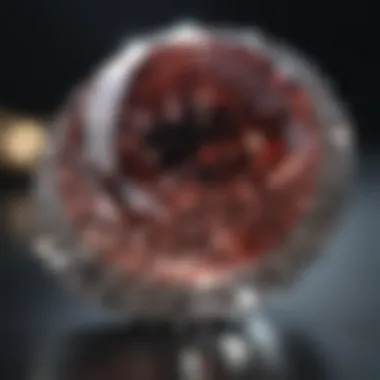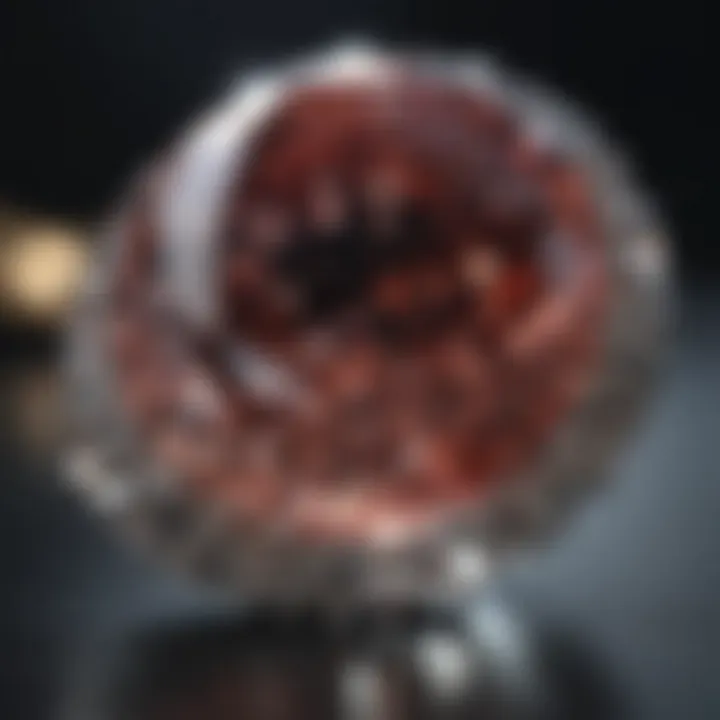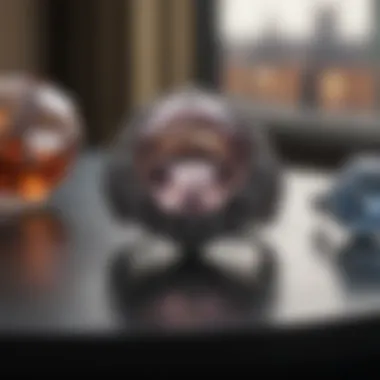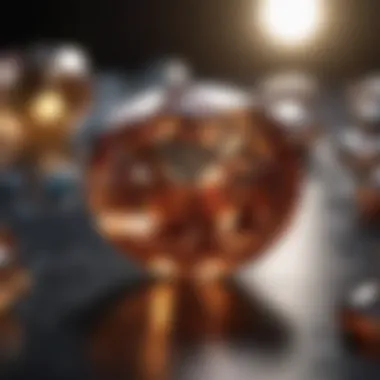Exploring the Impact of British Diamond Companies


Intro
Gemstone Overview
Definition of Gemstones
Gemstones are more than just attractive decorations; they are remarkable pieces of nature, often formed under specific geological conditions over millions of years. In a world where everything seems mass-produced, gemstones stand out as symbols of luxury, rarity, and beauty. Defined as a mineral or rock that can be cut and polished for adornment, each gemstone offers its own unique story and characteristics.
Classification of Gemstones
When discussing gemstones, understanding their classification is crucial. They typically fall into two main categories:
- Precious Gemstones: These include diamonds, rubies, sapphires, and emeralds. They are the stalwarts of luxury and are often characterized by their rarity, durability, and beauty.
- Semi-Precious Gemstones: These are more abundant and include stones such as amethyst, garnet, and aquamarine. While they may not hold the same status as their precious counterparts, they still offer vibrant colors and unique patterns that catch the eye and inspire creativity.
Such classification not only highlights their physical characteristics but also influences their market value. The rarity and desirability of a gemstone often dictate how it's perceived by consumers and collectors alike.
Historical Significance
Origins of Gemstone Use
Gemstones have been used by humans for thousands of years, serving not only as decorative pieces but also as symbols of power and connection to the divine. The British diamond industry, in particular, sprouted from this rich tradition, where diamonds were initially viewed as talismans thought to bring good fortune or ward off evil.
Cultural Insights: Gemstones in Ancient Civilizations
From the dazzling crowns of ancient monarchs to the simple adornments of early tribes, gemstones have adorned humanity through eras. Each culture seemed to have its own preference:
- Egypt: Gemstones were buried with pharaohs, believed to protect them in the afterlife.
- India: Diamonds were associated with tears of the gods, representing wisdom and strength.
- Rome: Emeralds signified love and rebirth, often worn by those in power.
In Britain, the crafting and wearing of diamond jewelry became an art, intermingling with the societal shifts of the monarchy and the burgeoning fashion industry. This blend of utility, beauty, and identity is what solidified their status in culture.
"Each diamond tells a story, from its formation deep within the Earth to its place in human history."
The intricate relationship between society and gemstones cannot be overstated, and as we delve deeper into the evolution of British diamond companies, we will see how their legacy continues to impact the global diamond landscape, fostering ethical considerations, artistic innovations, and an evolving consumer experience.
Prologue to British Diamond Companies
Exploring the world of British diamond companies reveals a fascinating tapestry of history, culture, and craftsmanship. These entities are not merely business ventures peddling gemstones; instead, they are rich legacies that have shaped not only the gem market but also societal norms and perceptions surrounding luxury and success. Understanding this segment is paramount for anyone eager to grasp the financial trends of luxury goods, the intersections of ethics in sourcing, and the artistry inherent in jewelry design.
Through this exploration, we uncover the multitude of factors that contribute to the legacy of British diamond firms, including their historical roots, innovative practices, and unwavering commitment to quality. The story extends beyond profitability; it encompasses cultural significance, the societal role of diamonds, and their position as symbols of status and elegance.
Historical Overview
British diamond companies trace back to the heights of the Victorian era, when prosperity surged, leading to an insatiable demand for fine jewels. A pivotal chapter in this history is the establishment of the De Beers Mine, which revolutionized the diamond trade by consolidating resources and controlling supply. Over time, Britain became a central player in this global trade, exporting not just gems but also the very ideals of sophistication that they represent.
These companies gained reputation through exceptional quality and innovation in cutting techniques, pushing boundaries to make diamonds sparkle with unprecedented brilliance. Figures like Harry Winston and his contemporaries set the bar high, driving the industry to new heights of excellence.
Further developments, such as advancements in technology and marketing, solidified their place in modern commerce. High-profile tenders and auctions elevated the status of diamonds, making them not just a luxury but an eventual canvas of personal expression.
Cultural Impact of Diamonds
Diamonds do not exist in a vacuum; they embody cultural narratives that reflect human aspirations and emotions. In British society, a diamond engagement ring serves as a rite of passage, symbolizing commitment and love. This tradition has roots in the marketing genius of companies like De Beers, who crafted the legendary slogan, "A Diamond is Forever," persuading generations of consumers about the timeless nature of their products.
Moreover, diamonds embody broader themes around status and identity. British royalty, often adorned in dazzling gem-studded tiaras and heirlooms, have played a crucial role in shaping public perception. Events like royal weddings see diamonds taking center stage, capturing the imagination of millions and solidifying the link between diamonds and nobility.
Traditions that encompass gifting diamonds at significant life milestones highlight the emotional value attached to these gems. They have come to represent not just luxury, but pivotal moments in life, such as anniversaries, graduations, and even successes in professional life.


As we delve further into the specifics of notable British companies and their innovations, it becomes evident that the diamonds they produce are laden with stories, mirroring the journeys of those who wear them.
Notable British Diamond Companies
The British diamond industry boasts historical significance and contemporary relevance that makes it a topic worthy of discussion. Notable British diamond companies not only have shaped the landscape of gemstone trading but have left indelible marks in cultural and economic realms alike. Understanding these companies provides insight into their craftsmanship, marketing strategies, and the ethical practices they embrace today. In the evolving landscape of the diamond market, the legacy of these companies plays a critical role in consumer trends and the economics surrounding luxury goods.
Historic Leaders
In the annals of the British diamond trade, several companies stand out as pioneers. Among them, De Beers took the crown and revolutionized the diamond industry in the late 19th century. Originally founded in Africa, its expansion into the British market highlighted a certain finesse in branding that emphasized diamonds as symbols of love and commitment. Their marketing prowess, encapsulated in the phrase "A Diamond is Forever," not only influenced consumer sentiment but also created sustained demand for diamonds.
Another key player is Boodle & Dunthorne, established in 1798. With its roots firmly planted in London's jewelry district, Boodle & Dunthorne became synonymous with bespoke design and exceptional artistry. The company crafted exquisite diamond pieces that often became heirlooms, thus imbuing their creations with historical value. Customers didn’t just purchase jewelry; they bought a piece of tradition.
Lastly, we cannot overlook Tiffany & Co. Although American in origin, its British boutiques reflect the intricate connection between the two markets. With their eye for detail and pursuit of excellence, Tiffany’s presence in Britain has catalyzed the evolution of diamond purchasing habits, especially among the upper class.
"The brilliance of a diamond extends far beyond its physical attributes; it is a reflection of the soul of the craftsmen and the narratives they weave into each piece."
These historic leaders set the tone for what consumers would come to expect from British diamond craftsmanship. Their innovations, both in marketing and design, have laid a solid foundation for what followed in the contemporary era.
Contemporary Players
The narrative doesn’t stop with the past; the present showcases a dazzling array of contemporary players who have redefined what it means to engage with diamonds. Companies like Graff Diamonds have emerged from the shadows of historic brands, marking their territory with audacious designs and high-quality stones that catch the eye. Their focus on rare gemstones and exceptional craftsmanship has captivated collectors worldwide.
Another noteworthy mention is Chopard, which has carved a niche for itself by emphasizing ethical practices alongside exquisite jewelry. Their commitment to sustainable sourcing and transparency resonates with modern consumers who are becoming increasingly concerned with the origins of the products they buy. This movement towards ethical consumption highlights a significant shift in consumer behavior, where buyers are just as interested in the stories behind the gems as they are in their aesthetic appeal.
These companies not only continue the legacy of British diamond craftsmanship but also engage in a discussion about sustainability and ethics within the industry. Their success demonstrates that luxury doesn’t have to come at the expense of ethical standards. As the market evolves, these contemporary players are learning to adapt by embracing innovation while respecting traditions that have made them prominent in the diamond industry.
Gemstone Sourcing and Supply Chain
The pathway from the depths of the earth to the elegance of a diamond ring is a journey marked by complexity and rigor. Understanding the gemstone sourcing and supply chain is crucial in grasping the overall legacy of British diamond companies. This aspect emphasizes not just the acquisition of these precious stones, but also the intrinsic values that govern their trade.
Diamonds do not simply land in a jeweler's showcase; they travel through a meticulously crafted network of miners, traders, and manufacturers before they reach consumers. Each stage of this supply chain holds significant implications for quality control, ethical standards, and consumer trust. A well-structured supply chain enhances a company's standing in the industry, as it reflects commitment to quality and integrity. Moreover, in today's market, consumers increasingly seek transparency. This desire prompts companies to clearly outline their sourcing practices, creating a foundation for authenticity that influences buying decisions.
From Mine to Market
The journey of a diamond begins deep within the earth. Mines, both large and small, span various continents, often with concentrated activity in regions like Africa, Canada, and Australia. Once extracted, diamonds undergo a rigorous sorting and classification process, which is critical to ensure that only the highest quality stones move forward in the supply chain.
- Mining Methods: There are different methods of extracting diamonds, including:
- Alluvial mining, which gathers stones from riverbeds.
- Open-pit mining, where larger deposits are accessed through excavation.
- Underground mining, typically employed for deep-seated deposits.
This stage sets the tone for the entire lifecycle of the diamond. The expertise during extraction can influence the final product's value and appeal. Following extraction, the stones move to sorting, where they are assessed and categorized based on their carat, cut, clarity, and color—commonly referred to as the four Cs. This phase demands both skill and an eye for detail, as the goal is to maximize value before any further processing.
Ethical Sourcing Practices
In recent years, the conversation surrounding the ethical implications of diamond sourcing has grown louder. Terms like "blood diamonds" or conflict diamonds have entered the lexicon, reminding consumers of the darker narratives behind some gemstone sources. Ethical sourcing practices have emerged as a critical area of focus for British diamond companies.
"Sourcing responsibly isn’t just good ethics; it’s good business. Trust is a currency today, and transparency pays off"
- Key Components of Ethical Sourcing:
- Conflict-Free Certification: Ensuring that diamonds are sourced responsibly without supporting armed conflict.
- Environmental Responsibility: Practices that minimize ecological impact while extracting and processing.
- Fair Labor Practices: Guaranteeing that the rights of workers are respected throughout the supply chain.
Companies that actively promote their ethical practices gain a competitive edge. Such efforts not only foster consumer loyalty but also contribute to a more sustainable industry overall. As gemstone enthusiasts and collectors become increasingly informed and selective, British diamond companies are compelled to adapt, ensuring that every diamond sold tells a story of integrity and excellence.
The Craftsmanship of Diamonds


The craftsmanship of diamonds is not merely about creating beautiful jewelry; it involves an intricate interplay of artistry, technical skill, and an appreciation for the material's natural beauty. This section seeks to explore how craftsmanship shapes not only the physical attributes of diamonds but also the very essence of what they represent in society. Given the historical and contemporary significance of diamond craftsmanship, its evolution reflects changing consumer tastes, technological advancements, and a deeper understanding of sustainable practices in the industry.
Cutting and Setting Techniques
The first step in crafting a diamond is the cutting process. This stage determines how light interacts with the gem, ultimately affecting its brilliance and overall appearance. Technicians known as gem cutters employ various cutting methods, including the brilliant, step, and mixed cuts, each bringing out different facets of the stone. For example, a round brilliant cut is designed to maximize the stone's sparkle by effectively reflecting light through its multiple facets.
This is important because the angle and depth of each facet can make or break the stone's visual appeal. The precision required in cutting is akin to that of a surgeon; a single misstep could result in a less valuable stone.
Setting techniques come next, which refers to how the diamond is placed within a piece of jewelry. Popular methods include prong, bezel, and pave settings. Each technique serves a different aesthetic purpose:
- Prong Setting: Allows maximum light exposure, enhancing sparkle.
- Bezel Setting: Provides a sleek, modern look while protecting the stone.
- Pave Setting: Creates a continuous surface of small diamonds, offering a dazzling effect.
Ultimately, understanding cutting and setting techniques is vital for any enthusiast who wants to appreciate the true artistry behind diamond jewelry.
"The beauty of a diamond lies in its hidden qualities, revealed only through expert craftsmanship."
Design Innovations
As the diamond industry has progressed, so have the designs that accompany these gems. From the classic styles of the Victorian era to modern minimalist aesthetics, innovation plays a crucial role in keeping the market alive and appealing to new consumers. Designers today experiment with various forms and settings that reflect contemporary lifestyle and fashion trends.
For instance, some artisans blend unconventional motifs with traditional styling, creating fusion pieces that attract a diverse audience. Consider the rise of ethereal designs, which utilize nature-inspired shapes and organic lines, adding depth and emotion to diamond jewelry.
Moreover, technology has revolutionized design possibilities, enabling 3D printing and CAD (Computer-Aided Design) to take center stage. These tools allow designers to visualize and perfect their creations digitally before actual production. This not only cuts down on waste but also offers unparalleled precision, a necessity in high-end jewelry craftsmanship.
- Innovations to consider include:
- Mix of materials: Combining diamonds with alternative stones or metals for unique contrasts.
- Sustainable practices: Using ethically sourced materials in innovative designs.
- Customization: Offering personalized pieces that resonate with individual stories and milestones.
In summary, the craftsmanship of diamonds encompasses not just how they are cut and set, but also how design evolves to meet the ever-changing landscape of consumer preferences. Acknowledging these facets reveals the layers of meaning embedded in each piece, solidifying diamonds’ status as prized possessions for generations.
Marketing Strategies and Consumer Trends
Understanding the dynamics of marketing strategies and consumer trends is crucial for British diamond companies seeking to thrive in a competitive marketplace. As the diamond industry evolves, companies must adapt their approaches to meet changing consumer preferences and market demands. This section dives into how strategic marketing influences buying decisions, brand loyalty, and overall market positioning.
Understanding Customer Preferences
In the world of diamonds, buyers are becoming immensely discerning. Today’s consumers are not just looking for exquisite products; they desire an emotional connection with their purchases. In this context, distinct buyer preferences have emerged that can influence marketing approaches:
- Ethical considerations: Many consumers prioritize ethically sourced diamonds. This trend has pushed companies to communicate their sourcing practices more transparently. Potential customers seek brands that align with their values, often opting for businesses that promote sustainable mining and fair trade.
- Customization: Personalization has become a buzzword in the jewelry world. Consumers want to wear pieces that reflect their individual styles or tell their unique stories. As a result, companies need to offer customizable options to cater to this demand. This can range from personalized engravings to bespoke designs developed in collaboration with the customer.
- Digital presence: The rise of e-commerce shifted how consumers engage with brands. Online stores, especially during the pandemic, became the primary shopping venues for many. Companies are now focusing their marketing efforts on online channels, employing social media and influencer partnerships to reach a broader audience.
By understanding what motivates customers, companies can better tailor their strategies, thereby ensuring successful engagement and long-term loyalty.
Brand Positioning and Identity
When we delve into how British diamond companies position themselves within the market, it is clear that branding plays a pivotal role. Brand positioning refers to the space a brand occupies in the minds of consumers relative to its competitors. A well-executed brand identity not only encompasses visual elements like logos and packaging but also extends to perceived values and customer experiences:
- Heritage and craftsmanship: Many British diamond companies emphasize their rich history and craftsmanship as key brand attributes. This narrative serves to evoke feelings of prestige and trust, appealing to consumers' desires for quality over quantity.
- Luxury and exclusivity: The diamond market often thrives on notions of desirability linked to exclusivity. Firms may invest heavily in branding that communicates high quality and limited availability, fostering a sense of urgency among potential buyers.
- Social responsibility: As consumers increasingly favor brands with a purpose, positioning around corporate social responsibility can significantly enhance a brand's appeal. Highlighting initiatives that give back to communities or promote sustainable practices can resonate well with conscientious consumers.
Brand identity is not just about what one sells; it’s about the narrative that surrounds those products and how they are perceived by the public.
Regulatory Environment and Standards
The regulatory landscape surrounding British diamond companies is a cornerstone of the industry, shaping how diamonds are sourced, traded, and marketed. This environment ensures that consumers are protected, and ethical practices are upheld. Given the historical contexts, such as the blood diamond trade scandals, regulations have become critical in boosting consumer confidence and ensuring accountability among companies.
Quality Control Arrangements


Quality control in the diamond industry serves as a yardstick for excellence. British diamond companies adhere to rigorous standards governed by several institutions and eye the four Cs—cut, color, clarity, and carat weight—recognized globally. However, the nuances of quality assurance extend beyond these parameters.
Companies often conduct internal reviews and audits, ensuring their diamonds not only meet aesthetic qualities but also align with ethical sourcing and sustainability practices. This layer of scrutiny fosters a culture of trust and transparency that resonates with customers.
- Expectations from Quality Control
- Benefits of Stringent Quality Controls
- Ensure compliance with international standards.
- Verify the provenance of diamonds through certificates and tracking systems.
- Uphold quality evaluations that are fair, unbiased, and of high standards.
- Enhances brand reputation and credibility.
- Minimizes risk linked to legal challenges or consumer dissatisfaction.
- Contributes to sustainability by encouraging vendors and suppliers to adopt eco-friendly practices.
Quality is not an act, it is a habit.
Legal Framework Surrounding Trade
The legal framework governing diamond trade in the UK establishes a clear set of regulations that work to ensure ethical sourcing, anti-money laundering measures, and consumer protection. The UK has implemented international commitments such as the Kimberley Process, aimed at preventing conflict diamonds from entering the market. Each diamond must be accompanied by a certificate proving it is conflict-free, thus encouraging responsible and fair trading practices.
- Key Legal Considerations
- Implications for Businesses
- Compliance with the Kimberley Process Certification Scheme.
- Adherence to laws concerning intellectual property, ensuring that designs and trade marks are protected.
- Implementation of measures against money laundering and financing of terrorism linked to diamond trade.
- Companies must invest in due diligence to comply with legal standards.
- Non-compliance can lead to significant penalties or even loss of licenses.
The Future of British Diamond Companies
The diamond industry is on the brink of a significant transformation. British diamond companies, long touted for their elegance and craftsmanship, are now facing a slew of challenges and opportunities as they navigate the complexities of modern consumer demands, environmental concerns, and technological advancements. Understanding the future trajectory of these companies provides valuable insights not just for investors but also for gemstone enthusiasts who are passionate about the artistry and story behind each jewel.
Emerging Trends in the Market
As we look to the horizon, several trends are becoming increasingly evident in the diamond market. Some of these trends are redefining how diamonds are produced, marketed, and appreciated:
- Lab-Grown Diamonds: With technology advancing rapidly, lab-grown diamonds are turning into a mainstay in the marketplace. They offer an attractive alternative to natural stones, often at a lower price point. British companies are now integrating these into their catalogs, appealing to a younger generation that values sustainability and transparency.
- Customization Demand: Modern consumers crave personalization. Companies are responding by offering bespoke services that allow customers to design their own pieces. This trend ensures that every diamond carries a unique narrative, aligning with the consumer's identity and values.
- Digital Engagement: The role of digital platforms is growing. Social media and e-commerce have become crucial in attracting attention and driving sales. British diamond companies that leverage these platforms not only reach a larger audience but also cultivate deeper relationships with their clients.
"In an age where social media dictates trends, the connection between a brand and its customer is more intimate than ever."
Sustainable Practices in Industry
The future also holds an expanded focus on sustainability. As the world becomes more eco-conscious, companies are under pressure to adopt practices that mitigate environmental impacts. Some key aspects include:
- Ethical Sourcing: More buyers are now scrutinizing where their diamonds come from. Companies are expected to provide clear information on the origins of their gemstones, ensuring that all practices are ethical and environmentally sound. There has been an increase in partnerships with suppliers who adhere to responsible mining practices, which is a shift from previous, less transparent practices.
- Recycling and Second-Hand Markets: The concept of recycling gemstones is taking root. This not only offers consumers a more sustainable option but also promotes a circular economy. British companies are championing this initiative by creating programs that encourage customers to sell back their older jewelry to be refurbished and resold.
- Sustainability Certifications: Certifications that validate the practices of companies are gaining prominence. Buyers are often more likely to purchase from brands that can prove their commitment to sustainable practices through recognized certifications.
In summary, the future of British diamond companies is poised to embrace change. From the rise of lab-grown diamonds to an increased focus on ethical sourcing and sustainability, the landscape is certainly evolving. These shifts benefit the entire industry, ensuring that diamonds remain a cherished symbol of beauty and commitment while aligning with modern values.
Epilogue
The exploration of British diamond companies provides significant insights into an industry that is both historical and modern. The evolution of these companies, from their inception to becoming global leaders in the diamond market, paints a picture that captures not just business, but artistry and ethical conduct.
Summary of Insights
The journey through the world of British diamonds reveals several critical themes that underscore the importance of this niche. Most notably:
- Historical Impact: British companies have shaped diamond trading practices worldwide. The establishment of trade routes and relationships during the colonial era laid the groundwork for present-day operations.
- Cultural Significance: Diamonds in Britain are often associated with prestige and celebration, embedding them in the very fabric of society—from royal engagements to high fashion.
- Ethical Considerations: Modern consumers are increasingly aware of the origins of their diamonds. Companies are adapting to emphasize transparency, sustainability, and fairness in sourcing.
- Craftsmanship and Innovation: The artistry in diamond cutting and design continues to evolve, reflecting contemporary tastes while honoring traditional methods.
As such, this legacy acts as a bridge connecting past practices with future innovations, ensuring that British diamond companies remain relevant in a rapidly changing global market.
Final Thoughts on the Industry's Evolution
As the diamond industry faces challenges including competition from synthetic stones and shifts in consumer preferences, the legacy of British companies will be pivotal. They must not only adapt to new techniques and consumer demands, but also remain committed to ethical sourcing and sustainability practices.
Ultimately, the road ahead may be fraught with obstacles, but the adaptability and heritage of British diamond companies provide a solid foundation for continued growth. As this sector moves further into the 21st century, a keen focus on innovation, consumer education, and social responsibility will likely define its next chapter.
The enduring appeal of these companies highlights a broader message: the diamond industry's future will depend on its ability to blend tradition with modernity, ensuring that the sparkle of British diamonds continues to shine bright for generations to come.



